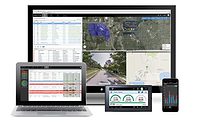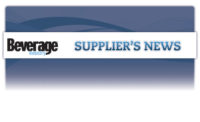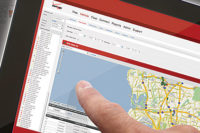Not all that long ago, fleet software defined a relatively narrow range of products that primarily were designed to track maintenance schedules and the related costs of vehicle operation/ownership. Integration with other IT functions meant that the fleet software might interface with accounting functions by providing summarized expense categories and rolling asset information.
Far too many fleets, especially the older and smaller ones, still rely on basic fleet management software, or generic office-suite database and spreadsheet software. If you looked far enough, you might even find a few paper-based systems still in use.
Today’s fleet software extends beyond the realm of just the shop and the bookkeeper’s office with connections to the customer, the front office, the C-suite, the shop, the truck and even the driver’s pocket.
Although it would be great if one software package could cover and manage the entire realm of fleet interactions, the reality is that any one-size-fits-all solution likely would be a poor fit for all.
With this in mind, the key question when looking at any individual piece of fleet software is how well does it play with others? Today, any fleet software worthy of serious consideration should be capable of off-the-shelf integration with other products from multiple providers of specialized fleet software, enterprise resource planning software and commercial-grade accounting packages.
If a fleet’s IT resources in other departments are strong and up-to-date, then it’s best to consider those fleet software offerings that are fully compatible with those existing systems. But, if the state of a fleet’s IT is antiquated, starting with the latest fleet software as the core of a new IT initiative, then extending that core by deploying compatible systems in other departments is likely the best strategy.
This is important for a number of reasons. Among those are the depth and breadth of outside connections/interactions with fleet software, and the potential for fleet software to have the biggest effect on the bottom line.
Although accounting software upgrades might lighten the bookkeeper’s workload, or produce a wider range of reports on-demand, there are few areas in a beverage distribution business, outside of fleet management, where software-driven processes can be applied across the entire and delivery chain to deliver substantial and sustainable improvements in profitability.
Whether fitting new fleet management software into an existing IT infrastructure, or building a new IT infrastructure around the latest fleet software that best fits a company’s operations, maintenance and cost tracking software rarely serves as the foundation these days. To be certain, tracking maintenance records and vehicle costs still are critical business functions, but they no longer are the “heavy lifting” functions in fleet software, instead they’re the “bread and butter” part of the whole package.
The core of the newest fleet software products tends to be focused on either telematics systems that track a truck’s position and provide mobile data communication or route/load optimization software that matches delivery demands against available resources to create the most cost-effective delivery strategies. The line between these two options is rapidly being blurred as vendors involved are increasingly merging, aligning or otherwise collaborating to offer both functions as an integrated package.
Cognizant of fleet software’s role in the overall IT universe, most top vendors of fleet software build off-the-shelf integration with other popular software packages into their products and typically will offer assistance with that integration when deploying their software.
Fleet software extends to driver’s pocket
Offering one example of just how far the reach of fleet software has extended, Paragon Software Systems, a popular provider of routing and scheduling software, launched its fleXipod system for electronic proof of delivery. Paragon’s fleXipod can be implemented using PDA, tablet or smartphone devices to provide real-time information on the status of deliveries, capture essential delivery information and provide user tracking through a GPS.
Unlike the better-organized receiving processes at high-volume/low-cost carbonated soft drinks and beer retailer accounts, receiving practices at wine and spirits on-premise accounts can be ad hoc under the best of circumstances. By providing photographic evidence of delivery and real-time signature capture, systems like fleXipod can dramatically reduce delivery disputes, adjustments and shrinkage in these higher-value/lower-volume segments.
Leveraging the built-in communications and navigation capabilities of the fleXipod-capable mobile devices also can provide fleets with a lower-cost telematics option integrated with Paragon’s routing software.
Considerations for when choosing a fleet software provider
The software arm of delivery giant UPS spun off as a standalone company. Now part of the Omnitracs family, Roadnet Technologies successfully leveraged its parent’s delivery expertise to develop routing software for third parties, with a strong following in the beverage industry. As part of a longer white paper available on the company’s website, Roadnet passes along these key tips for choosing a software vendor:
- Industry Knowledge: Has the vendor worked in your industry, with your type of operations? Every fleet operates differently, has different priorities, needs and even different regulatory issues with which to contend. You don’t want to be teaching a vendor about your business and customers.
- Training and Support: Will they be there when you need them? Training can’t be a one-and-done proposition. To fully leverage the features and advantages of your system, your users need ongoing opportunities to learn and apply new skills and techniques. Support personnel should be able to handle both technical and practical questions. Most important, good customer service works when you do, which isn’t always 9 to 5.
- Adaptability: Are the system’s methodologies flexible enough to align with your business? Can the system help you automatically balance customer service and profitability? Does it permit you to prioritize variables, such as preferred start/close times, time window requirements and other special rules that apply to your routes? The bottom line is routing software needs to conform to your business, and never the other way around.
- Technology Platform: Does it run the way you do? Talk to users, talk to other fleet managers, and, most importantly, ask endless questions. If the vendor you’re considering takes your questions in stride, it’s already a sign they are customer service-focused. With so many options available, no fleet, large or small, should have to compromise or conform to software limitations.






